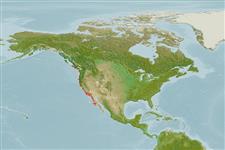>
Ovalentaria/misc (Various families in series Ovalentaria) >
Embiotocidae (Surfperches)
Etymology: Hyperprosopon: Greek, hyper = over + Greek, prosopon = face, snout of animal (Ref. 45335).
Environment: milieu / climate zone / depth range / distribution range
Ecologie
marien demersaal; diepte ? - 18 m (Ref. 2850). Subtropical; 52°N - 26°N, 130°W - 113°W
Eastern Pacific: Vancouver Island in British Columbia, Canada to central Baja California in Mexico, including Guadalupe Island (off northern central Baja California).
Grootte / Gewicht / Leeftijd
Maturity: Lm ? range ? - ? cm
Max length : 30.0 cm TL mannelijk / geslacht onbekend; (Ref. 2850); max. gerapporteerde leeftijd: 6 Jaren (Ref. 56049)
Dorsale stekels (totaal): 8 - 10; Dorsale zachte stralen (totaal): 25-28; Anale stekels 3; Anale zachte stralen: 30 - 35; Wervels: 33 - 37. Dark blue dorsally, sides and belly silvery with young having narrow golden vertical bars; tips of pelvic fins black; dusky on edge of caudal fin (Ref. 6885).
Live in surf on sand beaches and over sand near rocks, often around piers. Often occur in dense schools. Feed on small crustaceans. Viviparous, female carries the developing young (Ref. 205). Usually bear 5-12 young. An important game species.
Viviparous, female carries the developing young (Ref. 205).
Eschmeyer, W.N., E.S. Herald and H. Hammann, 1983. A field guide to Pacific coast fishes of North America. Boston (MA, USA): Houghton Mifflin Company. xii+336 p. (Ref. 2850)
Status op de Rode Lijst van het IUCN (Ref. 130435)
Gevaar voor de mens
Harmless
Gebruik door de mens
Visserij: commercieel; sportvis: ja
Meer informatie
ReferentiesAquacultuurAquacultuurprofielKweeklijnenGeneticaElectrophoresesErfelijkheidZiektesVerwerkingNutrientsMassaconversie
Tools
Speciale rapporten
Download XML
Internetbronnen
Estimates based on models
Preferred temperature (Ref.
123201): 10.7 - 19, mean 12.8 °C (based on 115 cells).
Fylogenetische diversiteitsindex (Ref.
82804): PD
50 = 0.6250 [Uniqueness, from 0.5 = low to 2.0 = high].
Bayesian length-weight: a=0.01905 (0.00831 - 0.04372), b=2.97 (2.77 - 3.17), in cm total length, based on LWR estimates for this (Sub)family-body shape (Ref.
93245).
Trofisch niveau (Ref.
69278): 3.5 ±0.50 se; based on food items.
Weerstandsvermogen (Ref.
120179): Gemiddeld, minimale populatieverdubbelingstijd 1,4-4,4 jaar (tm=1; tmax=6).
Fishing Vulnerability (Ref.
59153): Low vulnerability (20 of 100).
